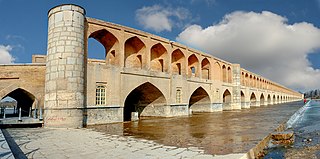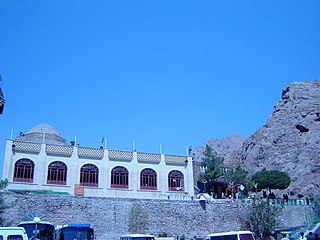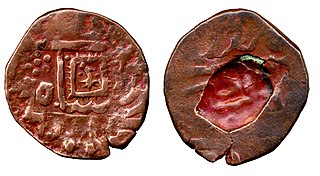
The Afsharid dynasty was an Iranian dynasty founded by Nader Shah of the Qirqlu clan of the Turkoman Afshar tribe, ruling over the Afsharid Empire.

Wilferd Ferdinand Madelung FBA was a German author and scholar of Islamic history widely recognised for his contributions to the fields of Islamic and Iranian studies. He was appreciated in Iran for his "knowledgeable and fair" treatment of the Shia perspective. In the obituary of the Institute of Ismaili Studies (London) where Madelung worked his last years, it reads: "With particular reference to religious schools and movements in early Islam, his studies, based on a vast array of primary sources, have enriched the discipline’s understanding of almost every major Muslim movement and community – not only early Imami Shi‘ism and the later developments of Twelver, Ismaili and Zaydi Islam but also the lesser known aspects of Sunni, Khariji and the Mu‘tazili schools of theology and philosophy."

The Allahverdi Khan Bridge, popularly known as Si-o-se-pol, is the largest of the eleven historical bridges on the Zayanderud, the largest river of the Iranian Plateau, in Isfahan, Iran.
Dinavar was a major town between the 7th and 10th centuries, located to the northeast of Kermanshah in western Iran. The ruins of the town is now located near Shir Khan, in Dinavar District, Sahneh County, Kermanshah Province.

The Encyclopaedia Islamica is an encyclopedia on Islamic and Iranian studies published by Brill, comprising a projected 16-volume translation of selected articles from the new Persian Dā'erat-ol-Ma'āref-e Bozorg-e Eslāmi, supplemented by additional articles written in English by scholars affiliated with the Institute of Ismaili Studies.
Farhad Daftary is a Belgian-born Iranian-British Islamic scholar who is co-director and head of the Department of Academic Research and Publications at the Institute of Ismaili Studies in London. He is related to the Aga Khan IV.

Bibi Shahrbanu Shrine is a shrine located near Shahr-e Ray, a southern suburb of Tehran, Iran.
The dehqân or dehgân were a class of land-owning magnates during the Sasanian and early Islamic period, found throughout Iranian Tajik lands. The dehqans started to gradually fade away under the Seljuks and Qarakhanids, due to the increase of the iqta' and the decline of the landowning class. By the time of their dissolution, they had played a key role in preserving the Iranian national identity. Their Islamization and cultural Iranianization of the Turks led to the establishment of the Iranian essence within the Islamic world, something which would continue throughout the Middle Ages and far into modern times.

'Ala' al-Dawla Simnani was a Persian Sūfī of the Kubrāwī order, a writer and a teacher of Sufism. He was born in Semnan, Iran. He studied the tradition of Sufism from Nur al-Din Isfarayini. He also wrote many books on Sufism and Islam. Among his students were Ashraf Jahangir Semnani and Mir Sayyid Ali Hamadani.

Ali Reza Abbasi Tabrizi was a prominent Persian calligrapher and calligraphy teacher, who flourished in 16th-17th century Safavid Iran. He was titled by Abbas I as Šāhnavāz Xān. Abbasi was a master of Naskh and Thuluth scripts and the initiator of his own style of Nastaʿlīq script. Besides he was an expert of various other scripts like Muhaqqaq, Reqa, Reyhan, Tevki and Taʿlīq scripts.
Ketāb-e Dīārbakrīya is a book on the history of the Aq Qoyunlu and Qara Qoyunlu Turkmen dynasties, written in Persian. The book is considered the most important primary source on the history of these two dynasties. The author of the book is Abu Bakr Tehrani. The book was written between 875/1469 and 883/1478.
Hamdan Qarmat ibn al-Ash'ath was the eponymous founder of the Qarmatian sect of Isma'ilism. Originally the chief Isma'ili missionary in lower Iraq, in 899 he quarreled with the movement's leadership at Salamiya after it was taken over by Sa'id ibn al-Husayn, and with his followers broke off from them. Hamdan then disappeared, but his followers continued in existence in the Syrian Desert and al-Bahrayn for several decades.

Javidhan was an Iranian landlord and leader of one of the two Khurramite movements in Azerbaijan, with his headquarters being in Badhdh. The leader of the other Khurramite movement was a certain Abu Imran, who often clashed with Javidhans forces. During one of the clashes, in probably the early 810s, Abu Imran was defeated and killed, whilst Javidhan was mortally wounded, dying three days later. Javidhan was succeeded by his apprentice Babak Khorramdin, who also married Javidhan's widow. Javidhan was survived by a son, who was most likely too young to succeed him.

The Jameh Mosque of Dezful first and oldest mosque built in Dezful, located in the Dezful County, is located on Imam Khomeini Street. The construction of this mosque is a Sasanian architecture style.
Abdurrahman Abdi Pasha, was an Ottoman official and historian. He served as kubbe veziri and as governor of several provinces, and functioned as the official court historian (vakanüvis) of Mehmed IV. Abdurrahman Abdi wrote an account of events covering 1648–1682, known as the Tarikh-e Neshanji Abdurrahman Pasha. Aburrahman Abdi also wrote poetry and was the author of commentaries on Attar of Nishapur's Pandnameh and on the poems of 'Orfi Shirazi.

Jahangir was the uncontested leader of the Aq Qoyunlu from 1444 to 1454, but afterwards fell into a dynastic struggle with his younger brother Uzun Hasan, who by 1457 had defeated him and assumed full power over the confederation. Jahangir later died in 1469.

Rustam Beg Bayandur was an Aq Qoyunlu prince, and one of the contesters in 1492–1497 during the dynastic struggle that had erupted following the death of Ya'qub Beg. He was deposed by his cousin Ahmad Beg.
Abol-Hasan Golestaneh was an Iranian government official from Isfahan, who wrote the historical chronicle of Mojamal al-Tawarikh in 1780. It was an important source for the events that followed after the death of the Iranian ruler Nader Shah, including the establishment of the Durrani Empire by the Afghan ruler Ahmad Shah Durrani, as well as the political affairs in western Iran between 1747 and 1782.

Abu Nasr Farahi was a Persian poet and lexicographer from Farah, Sistan, which is now in Afghanistan. Little is known about his life; he is known to have lived during the rule of the Nasrid dynasty and the early period of the Mongol Empire.
Hasanvand is a Lak tribe mainly settled in the Lorestan province of Iran. According to a 2008 census from the Statistical Center of Iran, Hasanvands had 1,121 households in their summer pasture in Lorestan.














